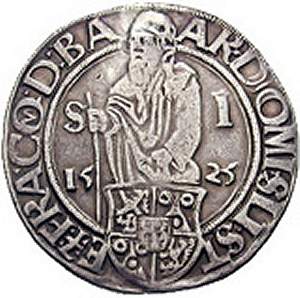Volume Two
Modern States
The Modern State and Its Coinage
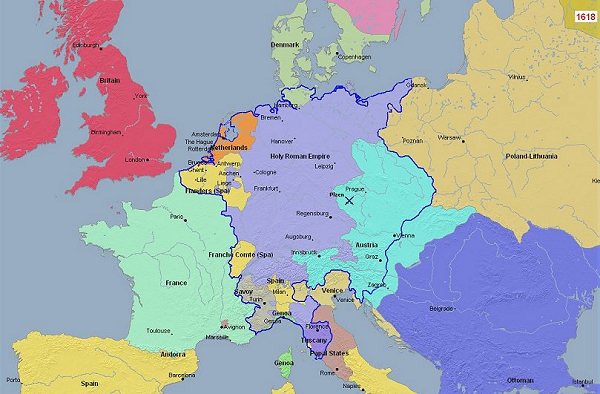
The Modern State
Many historians date the concept of the modern sovereign state to the Peace of Westphalia of 1648, which finally brought an end to a European war of almost unparalleled ferocity. The Thirty Years War started as a religious revolt in Bohemia but eventually dragged in all the regional powers — Denmark, Sweden, Germany, France, Bohemia and Spain — who expended vast treasuries on fruitless efforts to gain territory or religious control. {1-2} The greatest miseries were inflicted on Germany and Bohemia, which lost a third of their populations. The Swedish army alone destroyed 2,000 castles, 500 towns and 18,000 villages. {3} Mercenaries inflicted every barbarity imaginable, and those who survived the killing often starved to death or were reduced to cannibalism. In their wake came epidemics of typhus, dysentery and bubonic plague, and to the religious fanaticism was added monstrous superstition that claimed the lives of witches: tens of thousand were burned in grotesque mockeries of justice. As law and order collapsed, so did all human decencies and moral restraints: such is the brutalizing effect of prolonged and unprincipled warfare.
Indeed the Thirty Years' War brought few benefits to anyone. Spain lost Portugal and the Spanish Netherlands. Sweden emerged as a major power with control of the Baltic, but it was a dominance it did not long enjoy: the country lost territories to Russia in 1709. France gained Alsace, but not a solution to its religious dissensions. The Protestant cause was saved, but Germany further fractured into a mosaic of independent states, postponing unity by another two hundred years. What was really signified by the Peace of Westphalia is disputed, but many political analysts view in it the rise of the modern era in nation governance. Nations had legal rights, a concept now enshrined in the UN charter. Countries were no longer the personal possessions of their rulers, and territorial integrity had to be respected. Countries could also expect a first allegiance from their citizens, i.e. rather than to religious or ethnic groupings, which had often been the case before. Nations could permit religious diversity (as did France) but also had the right to impose a state religion: Catholicism or some variety of Protestantism (Lutheranism or Calvinism). European statecraft became a search for the balance of power. {3} As Lord Palmerston almost said: 'We have no permanent allies. We have no permanent enemies. We only have permanent interests.' {4}
The concept of national sovereignty did not, of course, suddenly emerge with the Peace of Westphalia but evolved gradually in response to men's thoughts on the world around them. The Roman jurist Ulpian (c. AD 170-223), for example, saw the state embodied in the Emperor, who was a law-making and abiding force. He was not bound by the law, but his word was the law — an absolutist conception of sovereignty. Ulpian was known to medieval monarchs, but their power generally fell short of being absolute because shared with feudal nobles. Civil wars in the sixteenth century did call for stronger centralizing powers, however, and Jean Bodin's 1576 "Les Six Livres de la République" argued that the very nature of the state required sovereignty be absolute. Of course that sovereignty would be bound by obligations and conditions, but was yet able to legislate without the consent of subjects. It was not subject to the laws of predecessors, and could not (logical) be bound by its own laws. Equally logically, sovereignty had to be perpetual, not a temporary delegation, because any time limit would imply a yet higher authority. Sovereignty did not involve a transfer a power from people to sovereign (as Ulpian had argued), however. It was natural law and divine law that gave the sovereign the right to rule, and those laws the sovereign could not contravene — only those laws (positive laws) made by human beings. {5-6}
Other historians would date the rise of the modern state to an earlier period, to Henry VII of England, Louis XI of France or Ferdinand of Spain, or even to Sicily under Frederick II (1194-1250). States were economic entities. They demanded obedience from all citizens and held a monopoly on the use of force — what Max Weber called 'legitimate violence'. They also participated in and emphasized the spiritual life, drawing their strength from religious and cultural values — all those methods, instruments, practices and habits of mind that make up a civilization. But first came order, and the compromise or balance between insufficient and excessive force were its laws. Threats to the state saw those laws imposed mercilessly, and often unfairly. Anyone supported by a state would likely be a member of its ruling class, and anyone opposed by the state would probably belong to the toiling masses. Dissent and sedition were serious crimes. Ambassadors acted as spies abroad, and armies of paid informers kept a listening ear on citizens at home. Torture and public execution were eloquent ways of demonstrating state power, and if that sounds callous we should remember that the same barbarities were practised much more frequently outside Europe at the time, in India, China or Siam, for example, and were simply accepted: they were not public entertainment and drew few crowds. {7}
Though anthropologists will argue that tribal societies are governed more effectively and humanely by social ostracism, states are not tribal societies but complex entities that collapse when order disappears. 'Legitimate violence' still applies today, and savage sentences were handed down on the perpetrators of the 2011 London riots. Good order is therefore the first necessity imposed after regime change. The French and Russian Revolutions rapidly became tyrannies, and the Thirty Years' War became a horror to all participants because the fighting lacked proper rules of engagement. Propaganda was everywhere essential. The ruler and his actions were presented in the most favourable light, and if artists of all descriptions dedicated their work to noble patrons, that ruling class in turn supported the government. In short, state violence and rough justice guaranteed internal peace and the ability to wage war effectively, which was the natural order of things in Europe until quite recently. {7}
Enlightenment thinkers rationalized matters by regarding sovereignty more as a social contract between ruler and people. In Thomas Hobbes' view — "Leviathan" (1651) — sovereignty was still logically absolute, but required that the ruler provide physical protection to the people. When the ruler failed to provide that protection, the people could recover their power and, if necessary, make a contract with another ruler. Jean-Jacques Rousseau's (1712-1778) definition was similar, but rooted sovereignty inalienably in the people, where it is indivisible and controlled by the common interest acting through the laws approved by the people. {6}
That balance of power did not extend to the world at large however, and many European powers exported their famous belligerence overseas, to a scramble for colonies, gunboat diplomacy and proxy wars. The English fought the French in India and north America. The Dutch seized the sugar-producing areas in Brazil, and the spice islands of the far east. Even America, very belatedly, took over Hawaii and the Philippines. With the collapse of the Soviet Union, the balance of global power has largely disappeared. America is now the world's sole superpower, and currently very unwilling to share the stage with an increasingly important China. {10}
To sole power and a balance of powers should also be added federation, which is being attempted by the EEC and trade associations between Russia, central Asia countries and China.
Modern states also required large funds, well beyond the personal wealth of their sovereigns. As they expanded and diversified their powers, states had to access the wealth in circulation, and in acceptable ways. Social and financial power structures thus grew up together, building on pre-existing hierarchies. Mirroring the government, the great offices of state and the powers of law and order became the financial and commercial centres of the capital cities, drawing on the wealth of specializations in the host country, and further, often far beyond the periphery, to countries that supplied natural materials or raw labour. Taxation was one route to funds, of course, but an unpopular one, needing considerable preparation, restraint and guile. When further taxation was out of the question, states had to borrow from overseas banks and merchants, repaying them in plunder from successful wars. {7}
The 15th century kings of Castile were the first to raise money on government bonds (juros) secured on part of the royal revenues assigned to that purpose. Charles V and Philip II of Spain used juros extensively, paying 5-14% interest on their various forms: a perpetual annuity, and annuity for life or a reimbursable bond. Juros could be bought and sold, generally at rates below their face value. There was also guaranteed stock ceded to businessmen who undertook by contract (asientos) to advance huge sums to Spain. In Charles V's time, the contract was with the Fuggers, the Augsburg bankers, who acquired grazing lands in Spain and the vital Almaden mercury mines when the loans couldn't be repaid. Genoese bankers replaced the Fuggers from 1557, and their asientos had to be continually extended, rolling over the debt and changing part of the floating loan to a consolidated loan when bankruptcies appeared (1557, 1560, 1576, 1596, 1606 and 1627). Indeed the last bankruptcy was deliberately engineered by Philip II to evade his creditors, though the attempt failed. The Genoese controlled the flow of New World silver into Seville, and could sell bonds on the Besanḉon fairs (Italians providing the money by speculation). The Venetian bankers were not so successful, however: defaults ruined them and the surrounding areas. {8}
The English innovation of a national debt was a large step forward, but a natural development nonetheless. By setting up a permanent loan and paying the interest through taxation, the government took matters into its own hands, cutting out the parasitic middlemen, tax collectors and overseas bankers, though at the cost of an inextricable involvement in the financial affairs of the City of London. {9} The innovation was practised cautiously at first, and England's participation in the War of the League of Augsburg (1689-97) and the War of the Spanish Succession (1701-13) were in fact funded by overseas loans. The country indeed raised money well into the 1720s by sale of government bonds on the Dutch markets, illustrating well before the 2008 financial crash the extraordinary power of banks and their intimate relationship to governments. Indeed England by the 14th century was financially bound to bankers in Lucca and Florence. France was at the mercy of Italian merchants for centuries, and in the 18th century succumbed to Protestant bankers. The Hofjuden were indispensable to Germany, and the Rothschilds served England well in the 19th century.
States did not exist in isolation, but as part of a larger social fabric. The Roman empire, though largely self-supporting, was a link in a vast trading zone extending from Gibraltar to China, through which passed precious manufactures, ingots, coins, gold and silver objects, pepper, cloves, ginger, lacquer, musk, ambergris, brocades, cottons, muslins, silks, gold-embroidered satins, dye-woods and perfumed woods and Chinese porcelain. Byzantium and the Islamic dynasties built their glories on such trade. Renaissance Italy inherited more than it originated, and even the rational and scientific world of Europe from the 17th century onwards had its roots in Chinese and sometimes Muslim inventions. Those two essential denominations of the Islamic world, the dinar and the dirhem, came from elsewhere. Byzantium supplied the dinar and the Sasanians the dirhem. {7}
With the growth of the modern state came capitalism, which is only part of a state's culture, though one under its jurisdiction. Capitalism became the sum of certain methods, instruments and habits of mind, which commerce is ever learning from other countries, modifying for its own purposes, and handing on to others. Double-entry book-keeping was brought by Venice by Jakob Fugger to Augsburg and thence to northern Europe, but the source, Luca Pacioli's 1496 "De Arithmetica", was only a summary of methods practised in late 13th century Florence. {7}
Budget forecasts do not appear until the 19th century, and early modern states simply kept an eye on the level of treasury coffers, raising a loan or taxes as indicated. Few knew even the full extent of their wealth or outgoings. Madrid's 1622 request for a retrospective financial statement was not delivered until January 1625. But states did limit trade flows. On several occasions in the 14th century there were embargoes on the export of grain from France, grain and livestock from Castile and iron to England by Aragon. What was especially, though often fruitlessly, lamented was the export of specie. Yet armies generally had to be paid with hard cash, preferably gold coins that could be carried on the person. Only Holland and then England appeared unconcerned by the outflows of gold and silver, probably because they were by then world powers thriving on overseas trade. {7}
Joachimsthaler

Spain used New World bullion sources to issue a portrait coinage, but the central European rulers had silver to hand from flourishing local mines. Sigismund of the Tyrol issued a large gulden (guldengroschen) in 1486, and Wladislas II of Hungary issued something similar in 1499. Several rulers followed: the bishop of Sitten, Zurich, Lucerne, the elector of Saxony, the landgrave of Hesse, the Ulrich duke of Wurttenberg, and the emperor and archduke Maximilian I, the archbishop of Bremen and then of Salzburg. {11}.
The first to strike the longer-lasting thaler denomination (from which the 'dollar' derives) was Stephen, Count of Schlik, who was lord of Joachimstal (modern Jachymov) on the Bohemian edge of the Erzgebirge (Ore Mountains {12}). The Kingdom of Bohemia, {13} the predecessor of the modern Czech Republic, was an Imperial State in the Holy Roman Empire, {14} where the Bohemian king was both a prince-elector of the empire and ruler of Bohemian Crown lands. {13}
The Habsburgs derive from Switzerland, where Rudolf I became Holy Roman Emperor in 1273, and installed his son as ruler of Austria. Through marriage and inheritance, the Habsburgs acquired the Netherlands (1477), Spain (1516) and subsequently Luxembourg, Burgundy, Bohemia, Hungary, Sicily, Naples and Milan. Allying themselves with the Catholic Church, they led crusades against the Protestants and Islam, attempting to exert control over the whole of Christendom, in which they were helped by fiscal and military innovations. Much of their wealth came from European silver mines, and then gold and silver supplies from the Americas, which were providing 10-20% of their revenues in the 1540s. {14}
Schlik itself was a backwater, however, and the Czech family owning the mining rights had not previously exercised them. But Stephan brought his brothers into the enterprise when the new mine proved unexpectedly rich, indeed became the richest silver mine in Europe by 1519, {11} with an output of 3 m. ounces/year (93kg/year). {15}
Silver Mining
 | The Europe-wide inflation (some sixfold between the early 16th century and mid 17th centuries) is not now laid solely at the door of New World supplies, {24} but those plentiful supplies of silver certainly helped to maintain the thaler as a popular denomination. {20} Many matters underlay the 1520-1640 inflation: the German silver mining boom, the influx of New World bullion, population changes after the Black Death, local wars, urbanisation, and the growth of credit institutions.{25} Isolating each contribution is clearly difficult. German silver mining started well before inflation took hold on Europe, for example, though much of the silver found its way to Venice (later to Antwerp) and thence to the Levant to buy luxury items, or was exchanged for west African gold. Both these gold and silver supplies were gradually superseded by New World sources. By 1550, Seville alone had received a total of 58,431 kg of gold, equivalent to 642,000 kg of silver at the 11:1 bi-metal ration for the period. {25} |
Reverse: Double-tailed bohemian lion. LVDOVICVS • PRIM(vs) D(ei): GRACIA REX BO(hemiae){3} | National policies also played some part, at least in unsettling currency values: England's great debasement under Henry VIII (1542-52), debasement in France in the years 1519 and 1541, Spain's debasement in 1537 and 1566. {25} |
Silver Mining and Trade
With silver mining came local industry and inflation, as in the American west. {26-27} Figures are contested but the documented quantities of silver extracted from central European mines were certainly large, perhaps some 17,000 kg/year of fine metal between 1471 and 1480. From 1491-1500 these new mines were producing some 25,000 kg annually, rising to a peak of 52,000 kg/year in 1531-1540 and then falling to 42,000 kg/year in 1541-1550. {25} New World supplies become significant after 1540, and gradually replace European supplies as those mines became exhausted or too costly to work. In 1561-70, for example, the cheaper silver imports from Potosi and Zacatecas had reached 84,000 kg/year. {25}
The central European mines did not spring up unaided. Saxony miners in fiercely independent guilds brought their skills and traditions.{29} Mining and metal extraction techniques improved. {30} South German merchant-financiers lent capital and arranged for the sale of metals in Venice and the northern ports, Danzig and Antwerp. Venice was much involved in exchanging silver for west African gold, and in shipping silver eastwards for Chinese needs, obtaining cotton goods and spices in return. The northern ports were part of the English wool trade, often finishing the goods for re-export through the Brabant fairs. Antwerp became pre-eminent when the English dropped their prices and Burgundian government debased its coinage. But, as always, there were local factors. As Antwerp became more gold-based, for example, England favoured silver, doubling its silver coinage from 1476 to 1500, Henry's VIII's great debasement notwithstanding. {25}
Equally important was a change in attitudes, away from the Church's ban on usury towards letters of credit and transferable bills that the Antwerp bourse protected by legislation and made discountable. Public expenditures also vastly increased, and, when Ottoman expansion blocked Venetian trade, the flow of silver to Antwerp became even more important, happily coinciding with an increase of silver from the Joachimsthal mines. {25}
The details and economic models are for historians to argue over — but the complex and interlinked nature of mining, coinage and trade is apparent on the simplest reflection. Gaps in our knowledge make medieval situations debatable, but, even today, when we are overwhelmed by financial data, and economists differ widely in their analyses and prescriptions, the social structures that link money, labour and natural resources are clearly vital to our well-being. {28}
History of the Thaler
The history of European art is illustrated by the thaler.
 | Saxony: Augustus: 1553-1586 Ar Thaler (40mm, 28.67 g, 12h). Dresden mint; Hans Biener, mintmaster. Dated 1578. Obverse: AVGVSTVS•D:G•DVX•SAXONIE•SA•ROMA•IMP•, armored, bare-headed bust right, wielding two-handed sword; date across field. Reverse: •ARCHIMARS CHAL•ET•ELEC, complex (12 part) coat-of-arms topped by three ornate helmets; HB monogram above. (Schnee 725; Sammlung Vogel 6651; Davenport 9798) {4}A realistic portrait in the northern European tradition, here verging on caricature. The sword and armour are symbols of his kingly duties. |
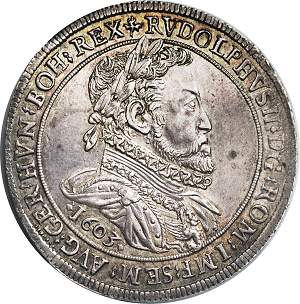 | Ar thaler. Austria. Rudolf II 1602-1605. 41 mm 28.28 g. Obverse: Laureate bust facing right with ruffled collar, in a beaded circle, clasp on shoulder. 1603 below bust. RVDOLPHVS II D G ROM IMP SEM AVG GER HVN BOH REX. Reverse: Composite arms with Tyrol at center top, under a crown, with chain of the Golden Fleece. The fleece divides the legend below, the crown on top. NECNON ARCHIDVCES A DVC BVR COM TIROL (KM# 37.1, Dav# 3005, KM# 37.3, Dav# 3005c) A splendid portrait in the late Renaissance manner, noble and dignified. |
 | Austria (Holy Roman Empire). Leopold I. 1640-1705. Dated 1699. Obverse: Narrow bust. Reverse: Crowned arms within Order chain (Dav-3245A (2) KM-1303.5 (2) Dav-3245 (1) KM-644.5 (1))No doubt the best the portraitist could achieve with so unprepossessing a model, but note the decoration unrelated to the coin design and awkward placing of the bust. We are back in the northern tradition of significant and symbolic detail. |
 | Ar thaler. Silver taler of Joseph II. Nuremberg. 1765. Obverse: City view of Nuremberg.: X. EINE FEINE — MARCK. 1765/ in exergue: NÜRNBERG./ S.R. Reverse: Laureated bust of Joseph II to r. with OEXLEIN.F. below. IOSEPHVS II. D.G. — ROM. IMP. SEMP. AVG.In Britain this style would be called Georgian: a mortal man presenting himself with decorum and intelligence. Note the unruffled elegance, balance and restrained richness of decoration.
|
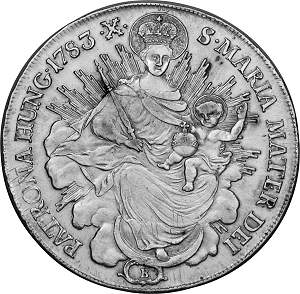 | Hungary. Ar Thaler Joseph II. 1780-1790. 28.06 g. Obverse: Hungarian arms. G.H.B. REX. A. A.D. B&L. IOS.II. D.G. R. IMP. S.A. (King of Germany Hungary Bohemia. Archduke of Austria. Duke of Burgundy. Bavaria and Lorraine. Joseph II. By the Grace of God. Emperor of the Romans, Ever Augustus ) Reverse: Holy family seated on cloud above mint mark. S. MARIA MATER DEI PATRONA HUNG 1783 (Mary, saint, mother of god, patroness of Hungary) ( KM# 395, H# 1869, ÉH# 1320)Note both the ornate, rococo styling of this beautiful piece, and the long parade of titles. Joseph II was in fact a patron of enlightened absolutism, a cultured and far-sighted ruler, but also someone who took his eminence and responsibilities seriously. |
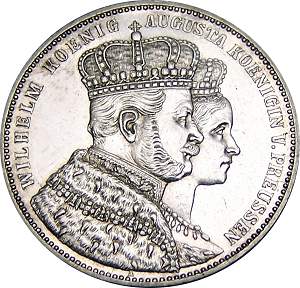 | Prussia. Ar Coronation thaler. 33 mm 18.52 g. Obverse: Heads right of Wilhelm I and Augusta. WILHELM KOENIG AUGUSTA KOENIGIN V. PREUSSEN. Reverse: Four crowns. SUUM CUIQUE W R A R W R A RKROENUNGS THALER 1861 ( KM# 488)We are in the nineteenth century in a Germany soon to become a leading industrial power: the portraiture is photographic, dry and severe — if not a little pedestrian and unimaginative: the figures are hardly invested with the aura of kingship. |
Maria Theresa
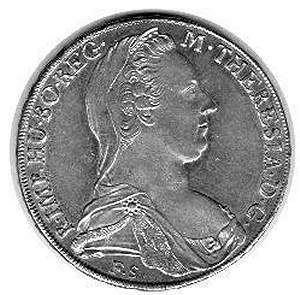 Ar thaler. Maria Theresa of Austria (1717 - 1780) 41 mm 27.91 g. Mint: Gunzburg. Obverse: Bust of Maria theresia right, large mint master’s initals initials (S.F.) below. M . THERESIA . D . G . R . IMP . HU BO . REG. Reverse: Crown above double headed imperial eagle, large multiple coat of arms with three crowns and lion.
Ar thaler. Maria Theresa of Austria (1717 - 1780) 41 mm 27.91 g. Mint: Gunzburg. Obverse: Bust of Maria theresia right, large mint master’s initals initials (S.F.) below. M . THERESIA . D . G . R . IMP . HU BO . REG. Reverse: Crown above double headed imperial eagle, large multiple coat of arms with three crowns and lion.
Legend: ARCHID . AVST . DUX . BURG . CO . TYR . 1780 X (Dav-1117 (23) KM-22 (6) Dav-1151 (5) Dav-1149 (1) Seaby-F (1)) A Maria Theresa thaler, struck posthumously at the Gunzburg mint in Germany during the 1792 -1805 period.
Maria Theresa was the last and only female ruler of Habsburg dominions. Though technically only consort to Francis I, she initiated financial and educational reforms throughout the empire, promoted commerce and agriculture, and reorganized the army, all of which strengthened Austria’s position and the stability of the succeeding Habsburg-Lorraine monarchy. Among her 16 children were Marie Antoinette of France and the emperor Joseph II. {21}
Maria Theresa is equally well known for her thaler, which became an international unit of bullion, circulating as legal tender (together with the Spanish eight reales) in British north America and then the United States. The thaler purchased slaves for the Southern cotton fields, and Egyptian cotton for textile mills in the North during the Civil War. The MTT went through 43 design variations before Maria Theresa's death in 1780, and was then issued posthumously in large quantities, the design showing small variations but all bearing the date of 1780. {22-3}
All coinage needs to show its legitimacy — through its metal content, design, and continuity with previous mintings — to be acceptable, and this was particularly the case for the MMT in Africa, the Levant and in other countries in Europe and east Asia. Users scrutinized the finest details of the coin, which even as late as 1982 served as wages for a child shepherd in Ethiopia, set at 12 MTT annually. {23}
References and Further Reading
Need the 36 references and 10 illustration sources? Please consider the inexpensive ebook.

